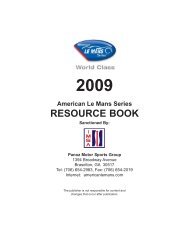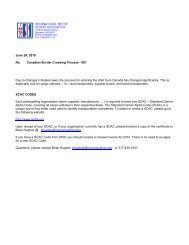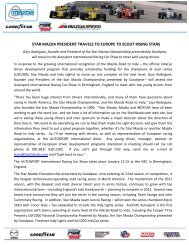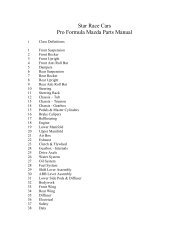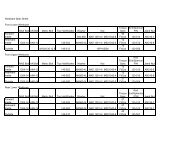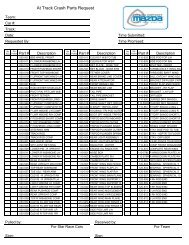You also want an ePaper? Increase the reach of your titles
YUMPU automatically turns print PDFs into web optimized ePapers that Google loves.
83 Carbon Metallic Highway • Clover, SC • 29710 • Tel: 803-222-2141 • Fax: 803-222-8134<br />
www.performancefriction.com<br />
Vehicle with Dual Master Cylinder and Racing Calipers<br />
Supplies needed:<br />
- 3 people<br />
- Supply of high quality brake fluid from an unopened container<br />
- 2 brake bleed bottles<br />
- 2 6 point box end or line wrenches for bleed screws on calipers<br />
Important Notes<br />
It is imperative that both ends of the car be bled simultaneously when using dual master cylinders. If<br />
this is not done, the master cylinders will not be adequately purged of contaminated brake fluid.<br />
Further, the balance bar assembly may be severely damaged, leading to a failure of the brake<br />
system.<br />
With the car on jack stands and a person sitting in the drivers seat:<br />
1. Place a wrench over the inboard bleed screw on one front and one rear caliper.<br />
2. Place the bleed hose attached to the bleed bottle over the bleed nipple with the wrenches.<br />
3. Open the bleed screws.<br />
4. With the bleed screw is open, have the “driver” slowly depress the brake pedal to the floor.<br />
With the driver holding the pedal down, gently close the bleed screws. With the bleeder<br />
closed, the driver can release the brake pedal.<br />
5. Repeat this process until the fluid coming from the calipers is clear and free of all air bubbles.<br />
6. Repeat this process for the outboard bleeders.<br />
7. Monitor the fluid level in the reservoirs and refill as necessary during the process.<br />
When finished torque bleeders to factory recommended settings Torque <strong>PFC</strong> bleed screws 48-60 inlbs.<br />
Repeat these steps for the remaining calipers, bleeding the front and rear circuits simultaneously.<br />
At times it is helpful to tap the caliper body with a soft mallet to release any small air bubbles trapped<br />
inside the caliper. At this point, the brake pedal should be checked for firmness and consistency. If<br />
the fluid is free of air bubbles and the pedal is still soft or spongy, there may be further issues that<br />
need to be addressed with the brake system. When finished, fill the fluid reservoir to the “full” line,<br />
but not over.<br />
Alternate Bleeding Methods<br />
The methods outlined above are not intended to be the sole methods approved for bleeding brake<br />
systems. However, they are reliable and repeatable techniques designed to minimize the cavitations<br />
that occurs when fluids move too rapidly through small passages and orifices. Bleeding brakes is not<br />
a pressure dependent process; it is a flow dependent process. All that is required is the slow and<br />
steady evacuation of contaminated fluid and air from the system.<br />
Power <strong>Brake</strong> Bleeders<br />
Power brake bleeders operate through applying external pressure to the brake fluid reservoir<br />
(pressure bleeders). If a power bleeder system is used, be sure a bellows or rubber diaphragm is<br />
used where the power bleeder applies its pressure to the reservoir area. This reduces water or other<br />
contaminants from affecting the brake fluid. Vacuum Bleeders apply a vacuum to the bleed screw at<br />
the calipers and draw the fluid out the system. These are typically used in car repair shops and are<br />
not generally considered acceptable for racing applications.



